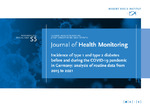Incidence of type 1 and type 2 diabetes before and during the COVID-19 pandemic in Germany: Analysis of routine data from 2015 to 2021
Reitzle, Lukas
Heidemann, Christin
Jacob, Josephine
Pawlowska-Phelan, Dorota
Ludwig, Marion
Scheidt-Nave, Christa
Background: To date, there is no data available depicting the trend of the incidence of type 1 and type 2 diabetes across all age groups for the COVID-19 pandemic years in Germany.
Methods: Based on anonymized routine data from nine million persons covered by statutory health insurance, newly diagnosed diabetes cases (ICD diagnosis E10.- to E14.-) in inpatient or (confirmed in two quarters) outpatient setting were estimated for 2015 to 2021, differentiating between type 1 and type 2 diabetes. The data were linked to the German Index of Socioeconomic Deprivation. The results are age-standardised (population as of 31 Dec. 2021).
Results: Between 2015 and 2021, the incidence of type 1 diabetes increased from 9.5 to 11.6 per 100,000 persons (from 7,007 to 8,699 new cases per year). In contrast, the incidence of type 2 diabetes tended to decline between 2015 and 2019. It continued to drop initially in 2020 during the pandemic, and then rose to 740 per 100,000 persons in 2021 (556,318 new cases per year). The diabetes type-specific seasonal pattern of previous years has changed during the pandemic years. The incidence of both type 1 and type 2 diabetes was observed to be higher in regions of high socioeconomic deprivation as compared to regions characterised by low socioeconomic deprivation.
Conclusions: The increase in the incidence of type 1 and type 2 diabetes in 2021 may possibly be related to the COVID-19 pandemic. The high incidence and the differences by regional socioeconomic deprivation indicate that there is a need for targeted prevention strategies.
Dateien zu dieser Publikation

